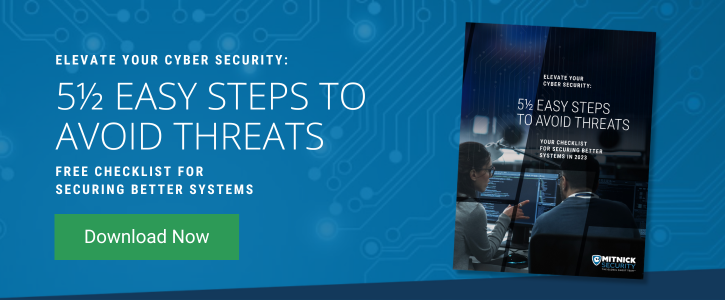If you’ve recently improved your cybersecurity posture, you should know that the work to protect your company’s data is not over.
That’s why it’s crucial to take a proactive approach to your cybersecurity and seek to remove as many vulnerabilities as possible.
In this blog post, we’ll provide tips for eliminating cyber security attack vectors and outline the cyber attack lifecycle to help you understand post-inoculation threats in greater detail.
What Is the Cyber Attack Lifecycle?
Threat actors often follow a process consisting of several tactics for successfully carrying out their attacks. This process is the cyber attack lifecycle.
The cyber attack lifecycle includes the following stages:
- Reconnaissance
- Compromise access or credentials
- Create a foothold and place implants
- Escalate privileges and maintain a hidden presence
- Launch main attack
The good news is that this cycle can be broken by advanced cyber security measures, mitigating the success rate of cyber attacks significantly.
When Do Post-Inoculation Attacks Occur?
Post-inoculation attacks are cyber security attacks that occur after a company has gone through extensive remediation from a previous attack(s). They can occur due to human error — like over 88% of cyber attacks — or vulnerabilities and attack vectors that are still present even after prior risk remediation.
If a threat actor has gone through the entire cyber attack lifecycle and was never removed from your network, they may maintain their presence and restart any necessary stages of the lifecycle once again for repeat attacks. If you haven’t broken their cycle, chances are they can reuse some of the cyber security attack vectors successfully.
Eliminating Attack Vectors in Post-Inoculation
Isolate and Record Threats
One of the first steps you should take during a cyber attack is to contain the attack and record all the information you can about it. This not only helps you contain the threat to one system but also helps you create a risk-remediation process better equipped to mitigate any similar cyber security attack vectors should the threat occur again.
Have the Capability To Protect and Roll Back Data Backups
Protecting data backups can be the sole factor in whether you remove cyber security attack vectors and vulnerabilities from your data or whether they remain.
We suggest the following best practices for your data backups:
- Store your data backups in several locations, both in the cloud and offsite
- Make your backups immutable, AKA unable to be modified after being backed up
- Backup your data and test it often for any threats
While the importance of having several protected data backups cannot be understated, it’s just as important to be able to roll back your backups to previous states.
Rolling back your files will allow you to restore them to previous versions, which may help remove vulnerabilities that occurred after updating.
Utilize the Latest Antivirus/Antimalware Software
One of the simplest tactics for mitigating cybersecurity attack vectors and vulnerabilities during post-inoculation is to utilize the latest antivirus/antimalware from a trusted company.
Your software should be able to detect and provide appropriate responses to each attack based on an internal playbook. If the software is doing its job correctly, you won’t have to worry about whether it’s detecting and responding in the best way.
Maintain Cybersecurity Compliance
Cybersecurity compliance is more than just protecting your clients’ data; it also ensures your company is best positioned to protect against the latest cyber attacks during post-inoculation.
Whether you’re in the financial, healthcare, or another industry that’s highly targeted, consider pentesting and other testing services that can help you reach and maintain compliance with relevant standards.
Leverage the Latest Resources for Proper Post-Inoculation Defense
Making improvements to your cybersecurity is not a one-and-done process, especially when considering the numerous post-inoculation attacks that can still occur even after refining your defenses. For the best cyber attack protection, you must prioritize your cybersecurity posture frequently, before, during, and after making improvements.
This means leveraging advanced testing solutions, such as pentesting, as well as equipping your entire enterprise with the latest educational cybersecurity resources.
Our team of seasoned cybersecurity consultants has created our guide, Learn to Avoid Cyber Threats in 5 ½ Easy Steps, to deliver organizations just like yours a foundation for fortifying your cybersecurity defense.
Download your copy of Learn to Avoid Cyber Threats in 5 ½ Easy Steps today to get started.



